Tempted by the thought of toasty toes? Here's how much to budget for your underfloor heating costs
Underfloor heating can transform the way you heat your home. But how much does it cost? We explore what you can expect to pay from installation through to bills
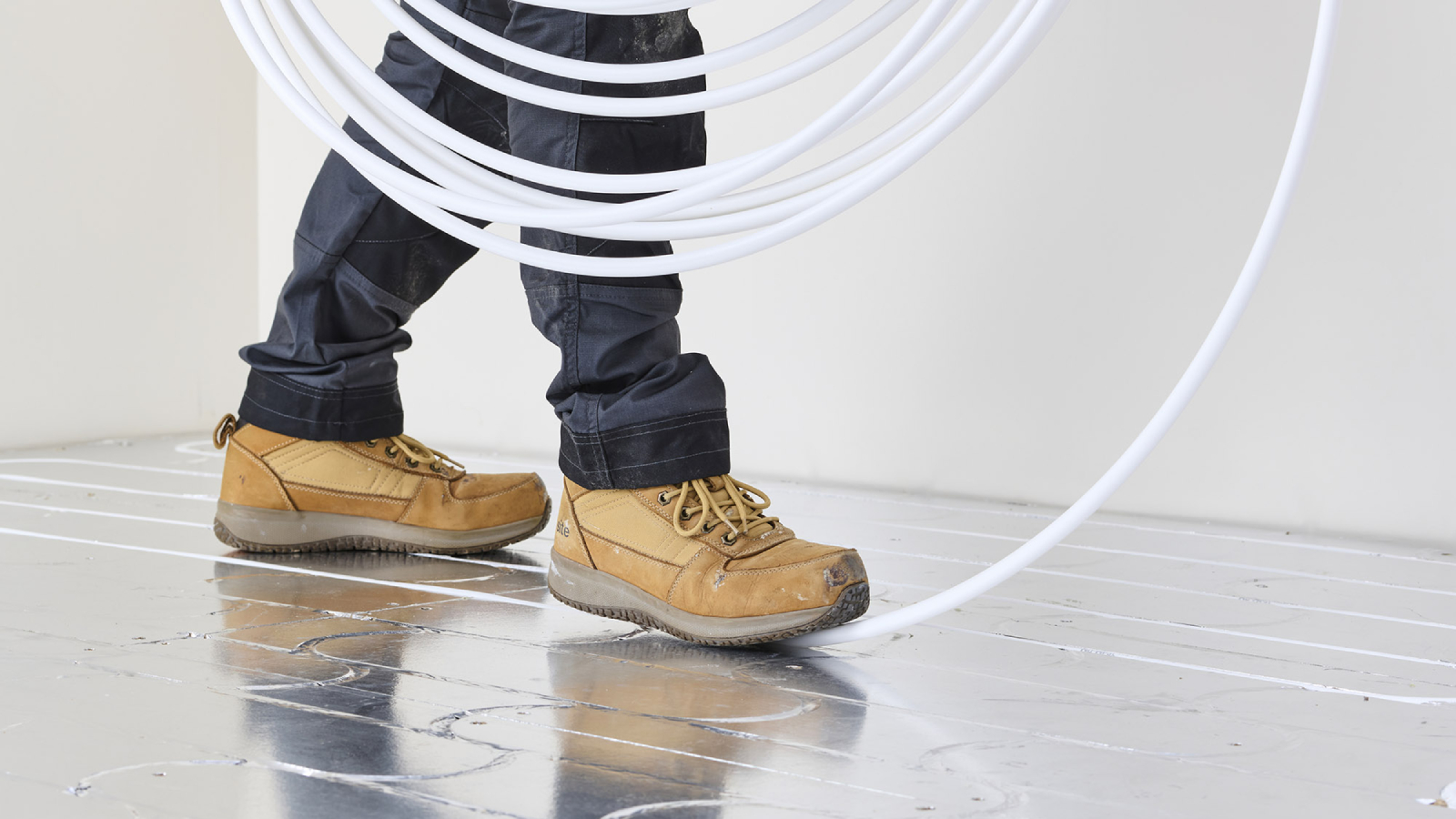
When extending, renovating or embarking on a self build, whether or not to install underfloor heating is likely to be a part of your discussions, with underfloor heating costs one of main factors to take into consideration.
There's no questioning that underfloor heating offers a discreet alternative to radiators, works well with heat pumps and can potentially provide you with a more uniform and energy efficient source of heat. But, how much will it set you back?
In this article, expert quantity surveyor, Tim Phillips, and renewable energy expert, David Hilton, explain everything you need to take into account when budgeting for underfloor heating costs.

Tim Phillips is an experienced senior quantity surveyor and estimator and has worked in the construction industry for over 35 years. He has worked on many varied projects in this time, for corporates, public bodies and private residential clients, managing multi-million budgets. For the past 13 years, Tim has worked on a freelance basis, whilst managing his rental property portfolio. He has extensive experience of undertaking his own full-scale house renovations. He is also a speaker and expert at the Homebuilding & Renovating Shows.
Costs vs benefits
Underfloor heating systems can be broadly classified into two systems: water-based systems (wet) and electric systems (dry) and this is the main factor that can influence your underfloor heating costs – both in terms of installation and running costs.
It's also worth bearing in mind that underfloor heating installation can be cheaper in new builds and extensions, as it can be designed in and planned for from the outset. Whereas in existing homes, it often necessitates the removal or lifting of existing floor finishes and potentially work to the subfloor, all of which can add to your expenditure
But, "although underfloor heating can involve a higher initial investment than a traditional radiator led system, and may require a slight adjustment period, it offers numerous benefits for health, efficiency, and comfort," says Simon Cook, head of sales at Nu Heat.
"Underfloor heating warms the room evenly from the floor up through radiant heat, eliminating cold spots and draughts. This radiant heating method is also more efficient, as it can heat a home effectively while operating at lower flow temperatures. In fact, UFH is 25% more efficient than radiators and up to 40% more efficient when combined with a heat pump.
Bring your dream home to life with expert advice, how to guides and design inspiration. Sign up for our newsletter and get two free tickets to a Homebuilding & Renovating Show near you.
"And of course, UFH saves valuable wall space," he adds, "as it is neatly concealed beneath the floor, eliminating the design restrictions created by different types of radiators, giving you complete design freedom."
Underfloor heating can also offer peace of mind when it comes to health and safety by eliminating bulky and hot radiators, instantly reducing the risk of burns, scalds, or trip hazards. With no pipes or sharp edges, it creates clean, open spaces that feel calmer and are easier to keep hygienic, with less dust and fewer surfaces to clean. It is also reported to be beneficial for those with arthritis and can ease symptoms of respiratory illnesses, thanks to lower dust circulation, humidity, and dust mites.
It also adds the opportunity to heat large open-plan areas as well as rooms such as bathrooms and kitchens where appliances and cupboards take up much of the wall area, leaving very little opportunity for the installation of heating emitters.
Through thorough evaluation of the system type and your property's unique requirements, it means you can make an educated choice that strikes a balance between up-front and ongoing expenses.
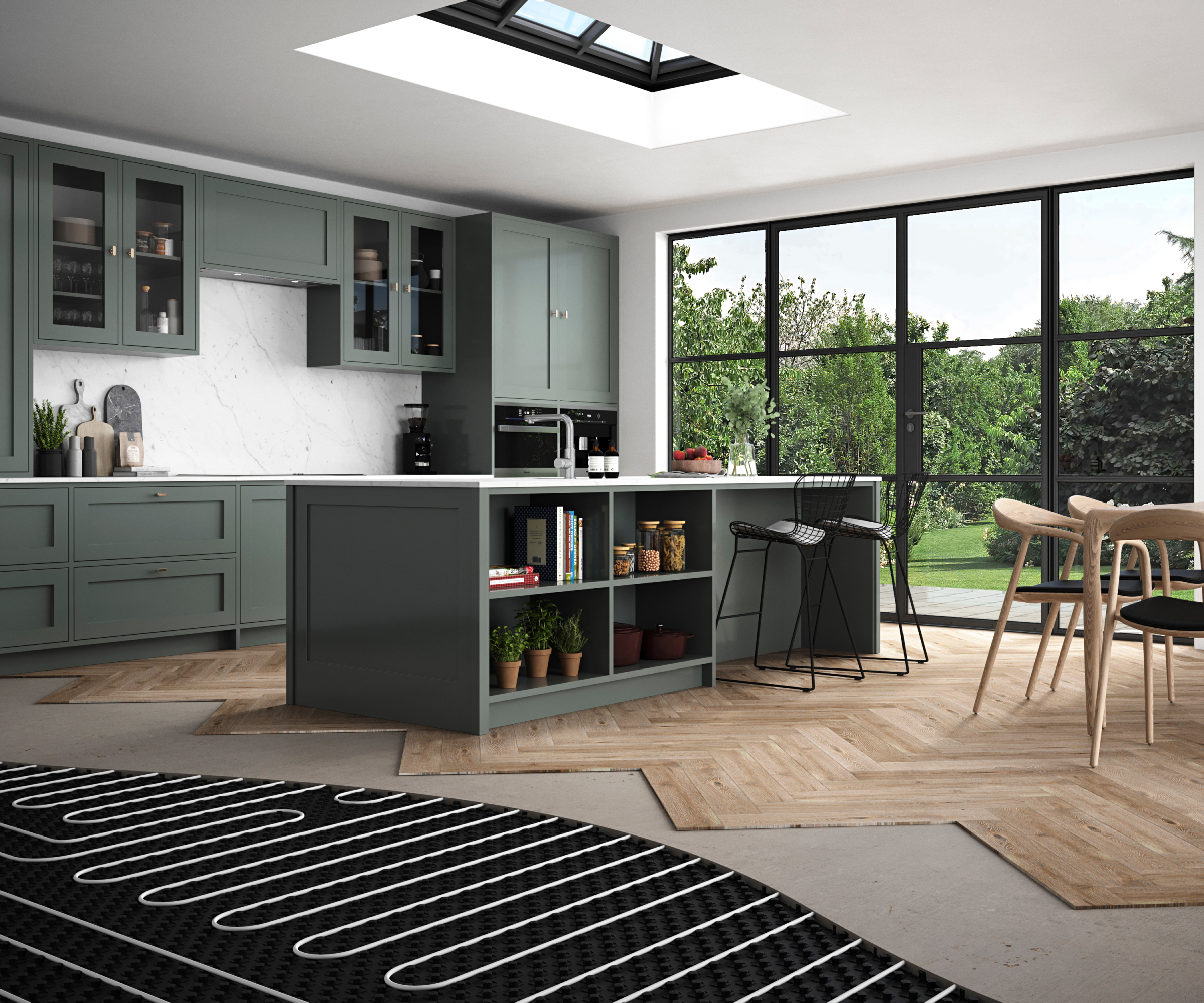

Simon Cook is head of sales at Nu-heat and has been with the compapny for over 10 years, helping homeowners with their underfloor heating requirements and helping them install the best system to heat their homes.
Electric underfloor heating costs
Installed under the floor, either in tailored panels or films or in the screed, electric underfloor heating is essentially electric wires whose resistance heats the floor, so warms the space.
Installing an electric system can cost between £28 and £97 per square metre depending on the size and type of system. However, the complexity of the installation and the particular needs of the property, may also impact the costs substantially
Potential floor height modifications and underfloor insulation, which is essential for optimising efficiency, are also additional costs you will need to take into account.
Most electric underfloor heating systems require insulation boards to minimise warm-up times and also reduce running costs, in some cases by 25%. Expect to pay upwards of £10 for a 1200 x 600 x 10mm board. Boards come in various thicknesses from 6mm up to 50mm for differing flooring situations.
You will also need to factor in the costs of your chosen underfloor heating thermostat and a typical digital 16amp will cost around £82. Your electrician will also need to connect up the power supply and sign it off. For a typical house, expect to pay between £255 - £330/day for an electrician or plumber.
Electric underfloor heating installation is a great option for smaller spaces or individual rooms because it is typically less expensive and simpler to install.
However, there are five main types of electric underfloor heating systems: cable, mesh, foil electric, matting and loose wire, and each comes with its own set of costs which we'll outline next.
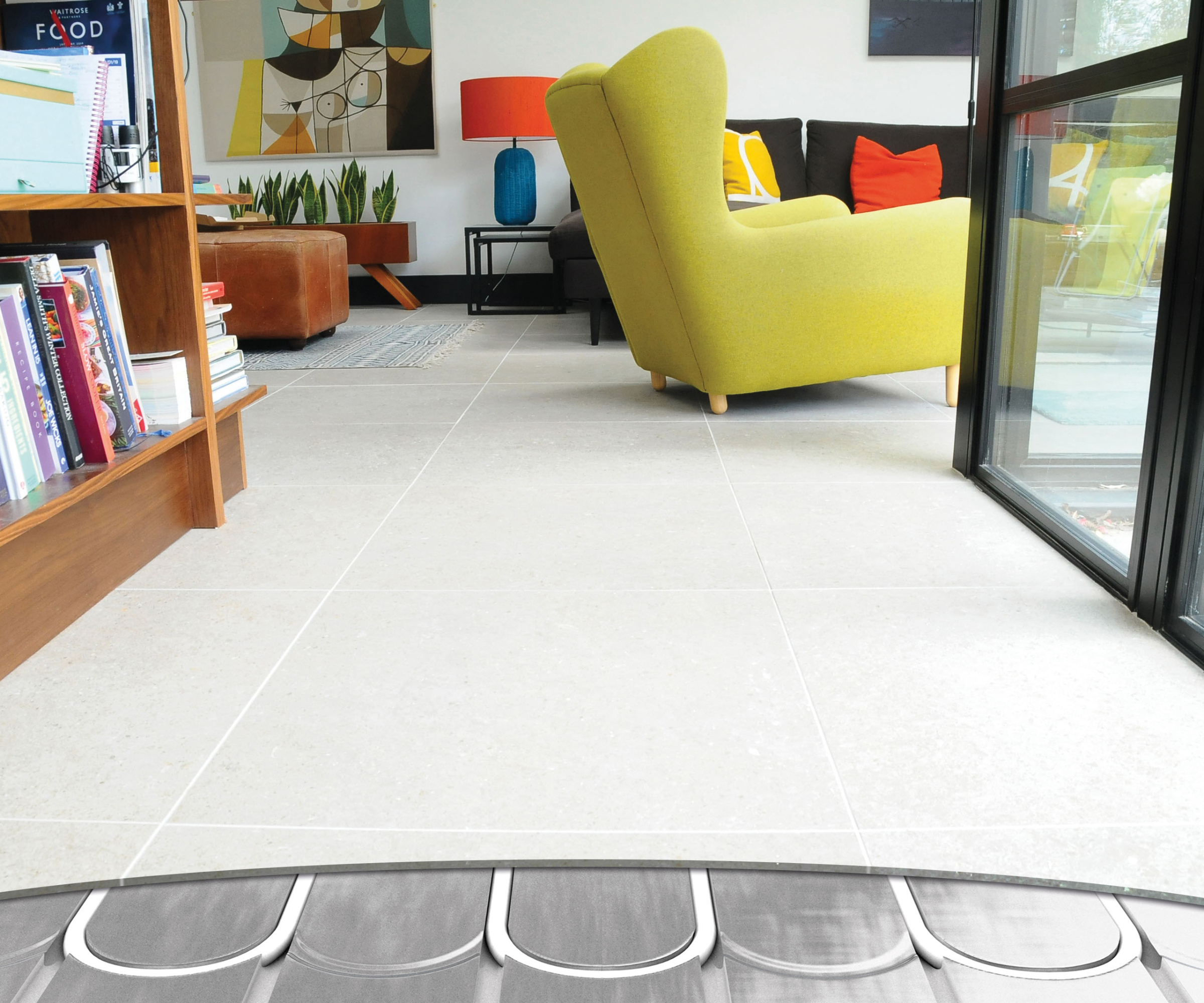
1. Cost of mesh electric UFH systems
Expect to pay around £55/m2 to £82/m2.
The thinnest system (best suited to tiled surfaces), this type of electric underfloor heating has wires that are attached to a thin mesh and the whole product is less than 2mm thick. The floor levels are not raised as the tile adhesive is then applied directly onto the mesh and the heater then effectively sits in the adhesive layer.
2. Cost of matt electric UFH systems
Expect to pay around £66/m2 to £97/m2.
For fast installation, this is a system with a matting that decouples the tiles from the subfloor. The matting is laid on the floor and the wires are pushed into preformed rebate cut-outs.
The adhesive is then applied to the matting, and as it is not applied direct to the subfloor, potential future seasonal cracking risk is also mitigated.
3. Cost of foil electric UFH systems
There is no requirement for a screed with this type of solution and you can expect to pay around £55/m2 to £87/m2.
Soft finishes such as carpets, vinyl and laminate as well as other floating floors can sometimes be a challenge with underfloor heating, but foil type systems are designed for this scenario. For more information on this topic, it's worth taking a look at our guide on underfloor heating with carpet or wooden flooring with underfloor heating.
4. Cost of loose wire electric UFH systems
Expect to pay around £66/m2 to £97/m2.
If the room has irregular shapes or permanent fixtures then a loose wire system is best suited to it. The heater is a durable, but flexible, cable that is stuck to the backing boards and is embedded in the levelling compound or adhesive. Installation is a bit more detailed but the product allows for a lot more design layout variation.
5. Cost of cable electric UFH systems
Expect to pay around £28/m2.
The cheapest electric underfloor heating system is a cable that is bedded in a screed. This system has thicker wires and allows for floor finish changes and screed thickness changes without damaging the wires.
The system is also slow to react and should be designed for long-term space heating and not for quick task heating for short periods of time.
Running costs for electric underfloor heating
The running costs of electric underfloor heating can vary depending on how much you pay for electricity, the capacity of the heating system per square meter and how long you leave it on for.
However, in general, it is certainly costlier than water-based systems, which can add up in the long run for bigger areas. That said, it’s ideal for retrofit situations or locations where installation height is a factor.
As an example, electric underfloor heating can cost circa £0.60 per day for a 4m2 bathroom with a 195W/m2 system which runs for three hours a day. So this could equate to around £18 each month. Look at the cost calculator on Thermosphere o see running costs for your situation and location.
But, as energy prices continue to fluctuate, make sure you look at the cost you are paying now, as well as the cost that you may be paying in the future. To help reduce your costs, check the time of any off-peak tariff and also make sure that if you have solar PV panels, you are using them with a solar battery so that you can store energy to use.
It is also worth bearing in mind that the underfloor heating will rarely be on all day, as the thermostat will only call for heat when it is required. The exact number of hours that it's on will depend on the efficiency of the room it's heating. But if you need a rough estimate, then use 50%, and probably even less in a new self build.
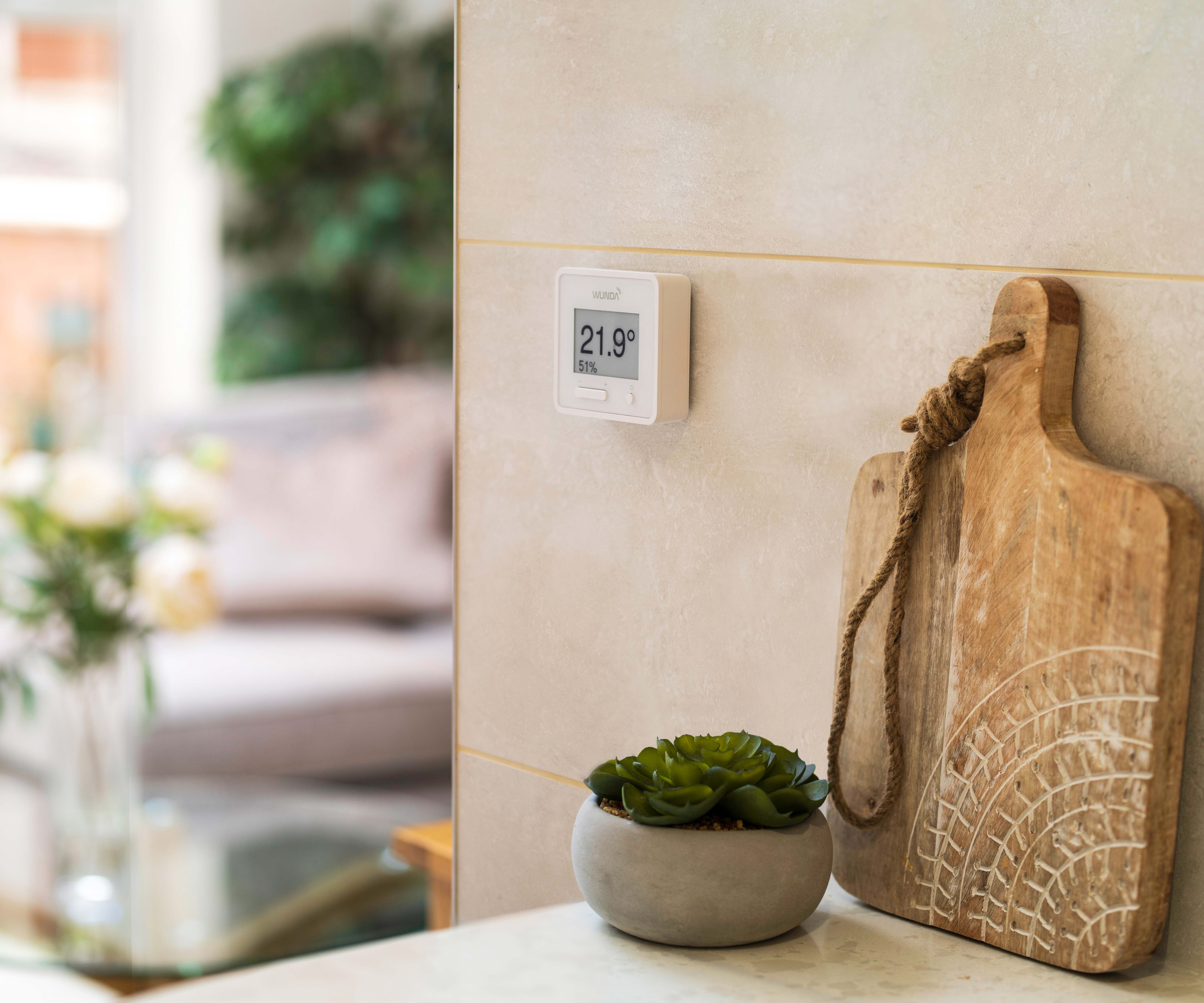
Costs for wet underfloor heating systems
There are two main types of water-based underfloor heating systems: buried pipe and surface-mounted pipe. They are usually more costly and intricate to install than electric systems, frequently necessitating significant alterations to the flooring and the heating system already in place.
"The most common way to install underfloor heating is to lay pipes over insulation and under a screed," explains Simon Cook. "Pipes are laid in rows, coiling where necessary, and evenly spaced to ensure an even spread of heat across the floor area. The pipes will be fixed using pipe staples.
"A self-levelling screed is then poured over the pipes, effectively burying them. Once poured, the screed is treated with a chemical spray to stabilise and tamped, before being left to dry."
The costs for installing a water-based system will depend on the type of build situation — is it a new build or deep renovation for example. In most cases, the underfloor heating company should include the design, pipes, thermostats, controllers, and underfloor heating manifolds and connectors in their quotation, as well as the installation.
Budget for material costs of £56 to £82/m2 for an average house, if you’re thinking of carrying out any install works on a DIY basis. If you think you'd prefer to leave it to a professional installer, the Warmup website suggests you can pay anything from £100 - £300 a day for an installer, and that an area of 40m2 will take around 2-3 days to complete.
“People tend to think underfloor heating is reserved for the rich but it’s really not. Installing underfloor heating across the ground floor of an average four bedroom house, (57m2) would cost in the region of £1500 to £2000,” comments Sam Jump, Head of Business Development, for Wunda Group. “Add to that the fact it can be easily DIY’d and you’re also cutting down on installation costs.”
Both systems will also require a separate heat source, so that could be a conventional combi-boiler, an air source heat pump or ground source heat pump. In addition to this you will have to include costs for a manifold and pump/mixing valve unit pack.
A small room requiring only a two-port manifold starts from £100 with a more complex 12 port costing around £385. A pump and mixing unit will be on average £250.
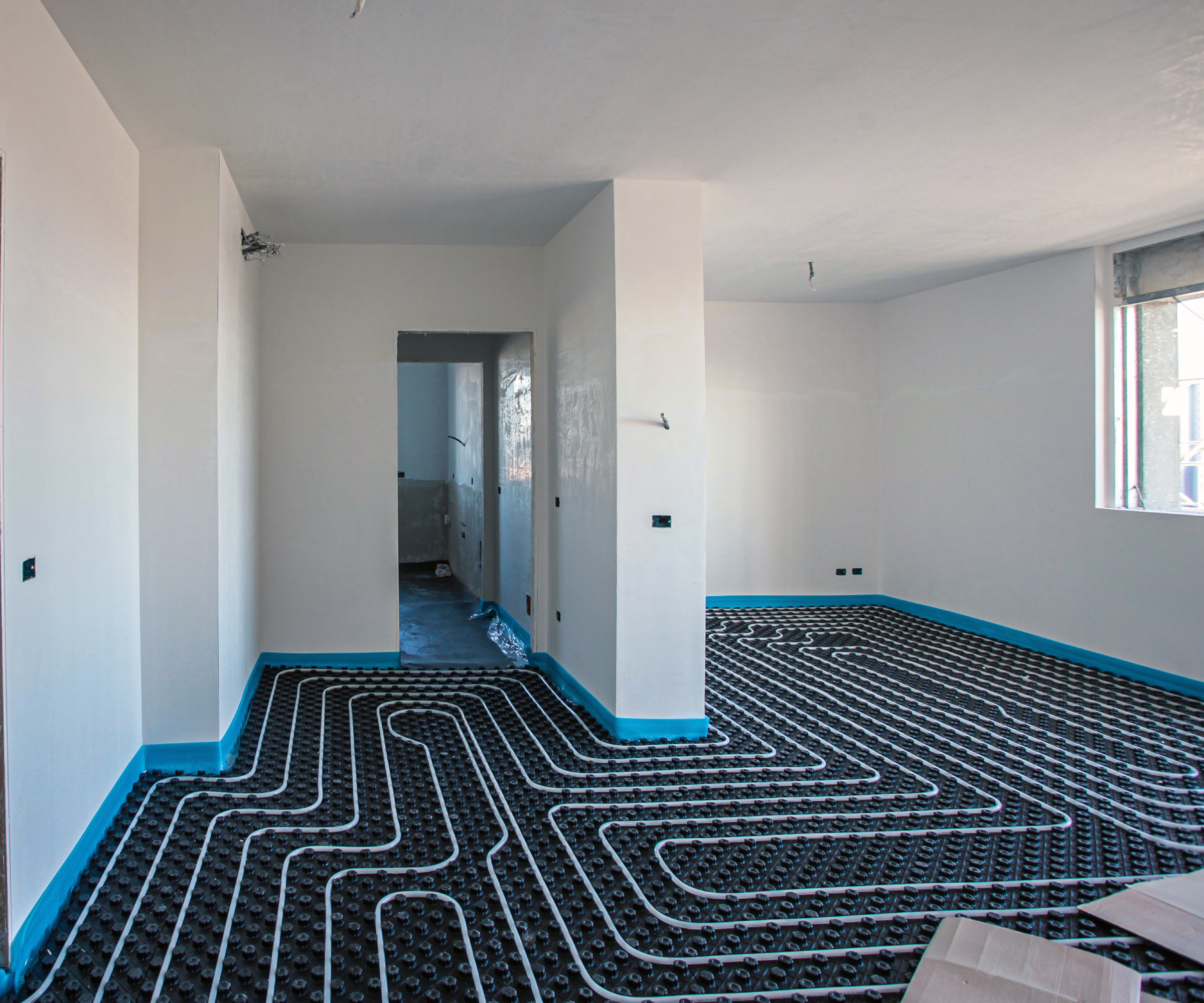
1. Buried wet UFH
Pipes can be clipped to your insulation boards and the screed can be laid over them embedding the pipes in the screed. The pipes can be in parallel lines across the floor or in a circular shape depending on the shape of the floor.
The pipes can also range between 10mm and 16mm diameter with the larger pipes being the most effective but also requiring more installation space.
The cost of the pipework will vary depending on the quality of the pipe and the lengths used. As it is not good practice to have joins in the pipe loops there can be quite a bit of wastage if the loops are not carefully planned.
2. Surface-mounted wet UFH
On a joist type floor, such as first floors, underfloor heating pipes can be installed under the floorboards by either fitting them from the room below (before the ceiling is fitted), or by notching the joists and installing the pipework before fitting the floorboards.
Another method is to use an ‘overlay’ system where the pipes are fitted into a preformed board that has rebated grooves for the pipes to be pushed into. The groves are preformed at around 150mm centres (for 16mm pipe) and has a thickness of around 20mm.
Smaller bore pipes will have the grooves closer together and the boards may also be a bit thinner. The boards are often made of high density polystyrene but there are also wood fibre boards, plastic boards and heavier composite boards. As with any additional changes you are making to the structural elements of the home you will need to make sure that any additional weight of the system or notching of beams is within the structural tolerance of the materials.
Wet underfloor heating running costs will depend on your home
While the initial outlay in installing wet underfloor heating is often more expensive, in the long run a wet system is typically cheaper to run than an electric underfloor heating system.
The real expense is how much energy the home needs. If the room requires 500W to keep it warm then you will want to optimise the way the heat is delivered to the water in the system.
If you use direct electric to heat your water then it will be around three times more expensive than heat pumps or a gas boiler.
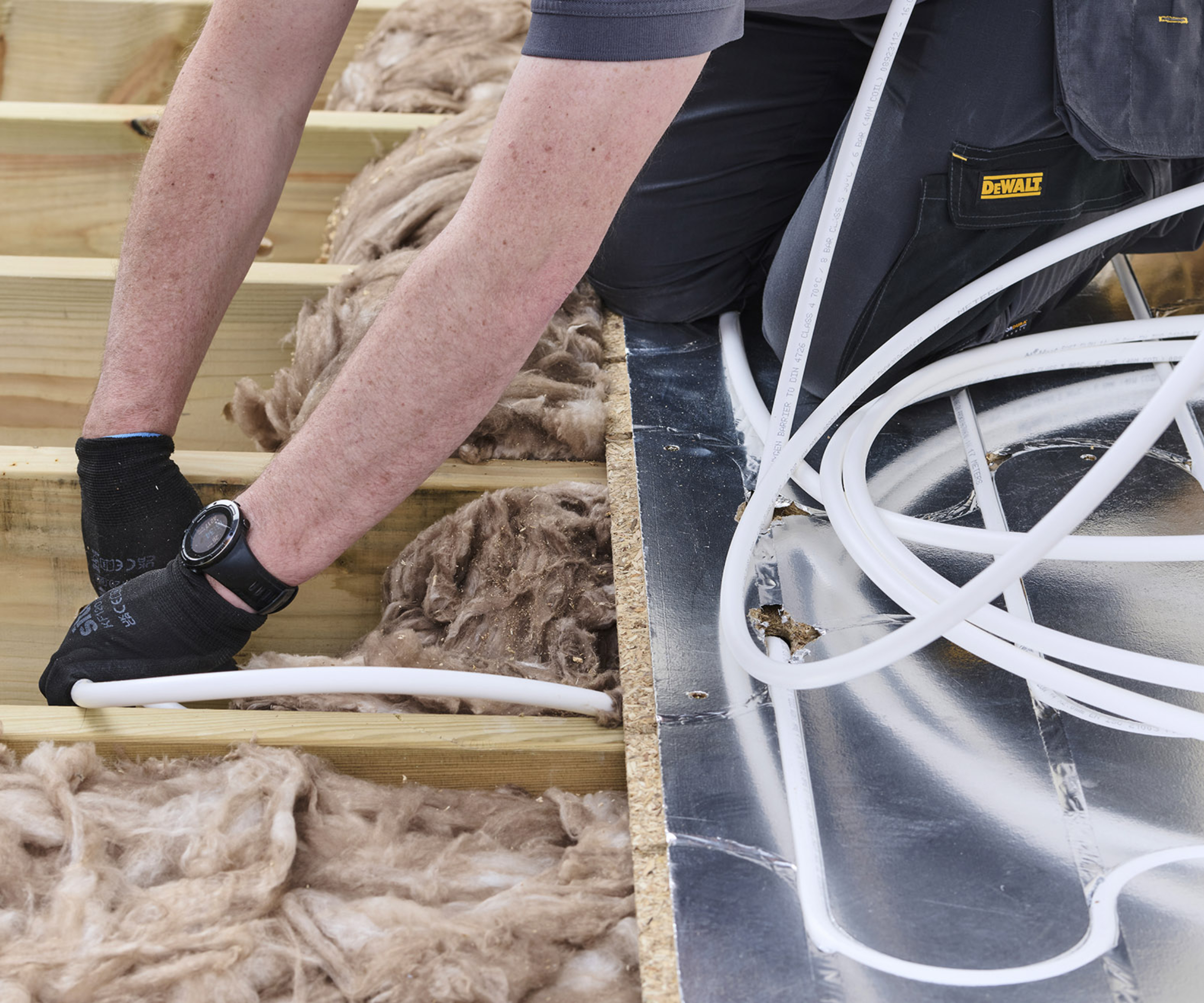
Maintenance costs
Even though underfloor heating systems don't require much maintenance, it's still necessary to plan ahead to make sure they stay functional and efficient. With proactive maintenance such as yearly inspections, bleeding your underfloor heating, recurring flushing for water-based systems, and timely repairs, when necessary, homeowners can extend the life of their underfloor heating system. Here are some factors to consider:
- Annual service – A professional's yearly inspection may assist guarantee that your underfloor heating system is functioning well and can spot any possible problems before they get out of hand. Regular maintenance usually costs around £185, depending on the system's size and complexity.
- Flushing water-based systems – Periodic flushing of water-based underfloor heating systems may be necessary to get rid of any buildup or sludge that could be affecting the system's performance. Usually, this is advised every five to 10 years. Although the price to flush a system can vary, it usually costs £360.
- Repairs and spares replacement controls and thermostats – Depending on the type and features, replacing a failed thermostat or control unit might cost anywhere between £55 and £200.
- Water-based systems: pumps and valves – These parts may eventually need to be replaced due to wear and tear and can cost anything from £100 to £300, not including labour.
- Modifications and reassessments - To make sure the system is performing at its best, it might occasionally need to be recalibrated. Typically, this service is less costly, ranging from £40 to £80.
- Unexpected problems - Issues such as leaks in water-based systems or electrical faults in electric systems can occur, though they are uncommon. Timely resolution of these issues is essential to avert more harm. The price range is wide; small repairs may run up to £100, while more serious problems may end up costing several hundred pounds.
FAQs
Which is more expensive: Underfloor heating or radiators?
The simple answer when it comes to underfloor heating vs radiators is that it very much depends on your home, project and product.
When it comes to installation, adding radiators can be fairly simple compared to adding underfloor heating. There's far less disruption to a room, and a radiator can often be fitted simply where there is wall space (piping can be more tricky but still relatively straight forward). They are also quick and inexpensive to fit.
Adding any kind of underfloor heating meanwhile will require total upheaval of the flooring, which is usually expensive when retrofitting underfloor heating. This is certainly true when it comes to wet underfloor heating, making installing radiators far cheaper.
Building a new home or extension, however, provides an opportunity to design in and install underfloor heating from the outset.
When it comes to running costs, wet underfloor heating, if it is installed with good insulation in a well-insulated home can be more energy efficient than radiators. At most, it is estimated to be around 25% more efficient than radiators.
That does differ for electric underfloor heating systems as the cost of running this very much depends on the unit price of electric, which is often far higher. The same of course applies for electric radiators.
The final consideration is longevity and maintenance. Radiators are easily accessible and therefore easier to access to maintain. Underfloor heating meanwhile, if it goes wrong will often require the floor to be dug up. That said, radiators have a lifespan of up to 10 years, while underfloor heating is claimed to have a lifespan of up to 50 years.
Can I install underfloor heating myself?
DIY installation of underfloor heating can be a cost-effective option for those with the necessary skills. This could involve some of the simple labour-intensive works like cutting and laying the insulation boards, applying adhesive, or fitting the matting or wire system.
However, it's crucial to consider the complexity of the project, the need for compliance with building regulations, and the potential impact on warranties and insurance. You would in most cases still require an electrician and/or a plumber to carry out final connections i.e., thermostats and manifolds.
This approach ensures a reliable and efficient heating system, providing peace of mind and long-term savings.
Want to make sure you get the right flooring on top of your underfloor heating? Read our guide to the best flooring for underfloor heating and if toasty toes after bath time is your main objective, find out more about underfloor heating in bathrooms.
David is a renewables and ventilation installer, with over 35 years experience, and is a long-standing contributor to Homebuilding and Renovating magazine. He is a member of the Gas Safe Register, has a Masters degree in Sustainable Architecture, and is an authority in sustainable building and energy efficiency, with extensive knowledge in building fabrics, heat recovery ventilation, renewables, and also conventional heating systems. He is also a speaker at the Homebuilding & Renovating Show.
Passionate about healthy, efficient homes, he is director of Heat and Energy Ltd. He works with architects, builders, self builders and renovators, and designs and project manages the installation of ventilation and heating systems to achieve the most energy efficient and cost effective outcome for every home.

